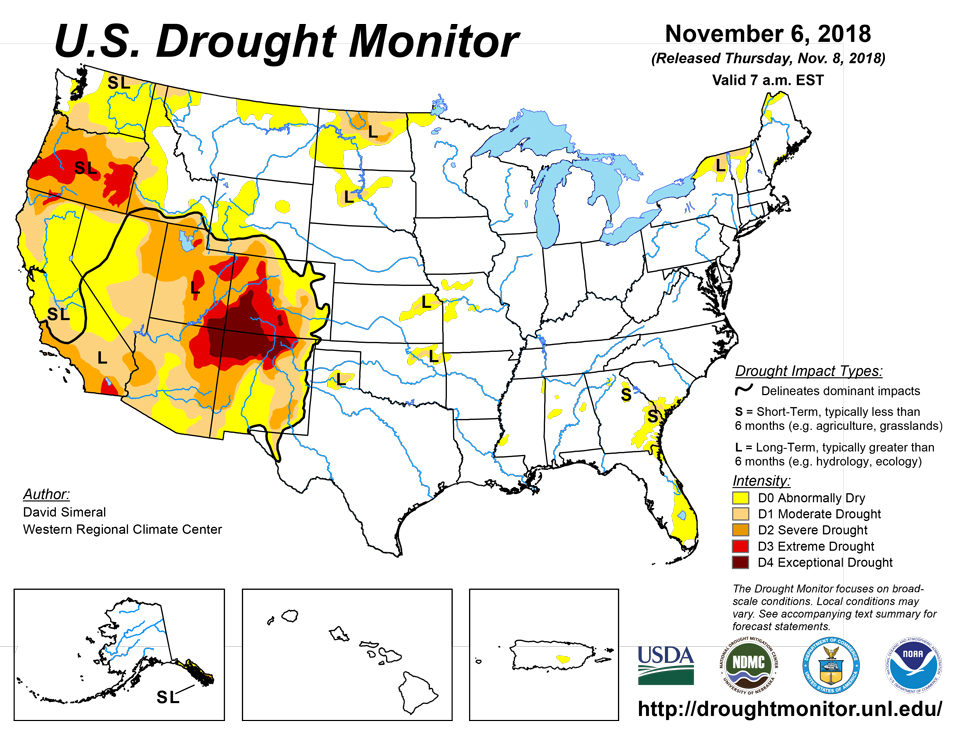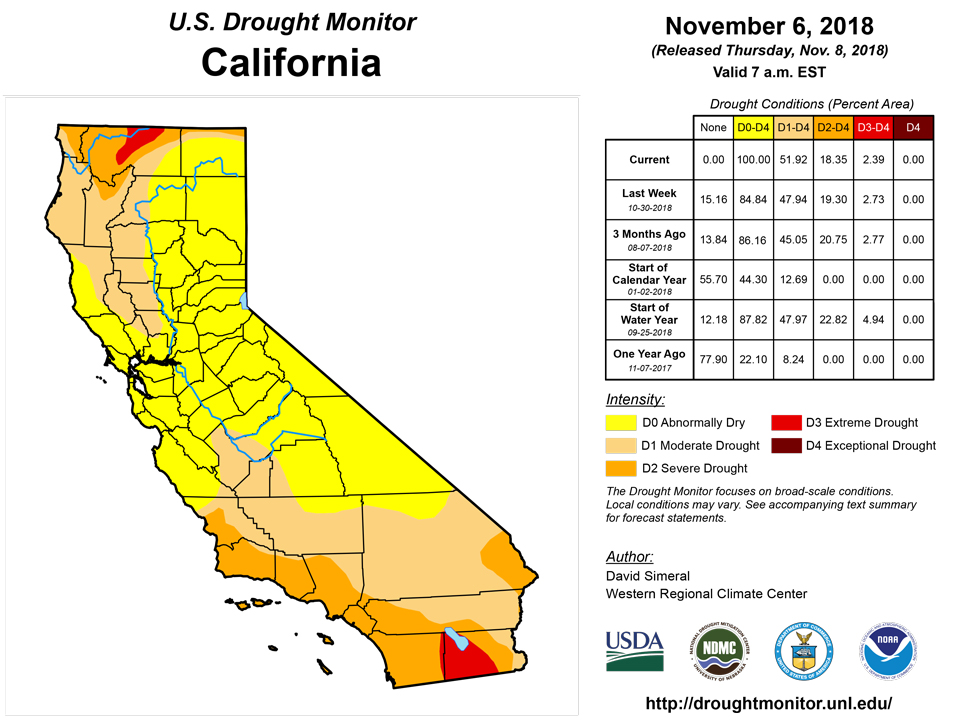Statistics

California and National Drought Summary for November 6, 2018
Summary
November 8, 2018 - This U.S. Drought Monitor week saw improvements on the map across portions of the Pacific Northwest as well as in the northern and central Rockies where scattered rain and mountain snow showers helped to boost snowpack levels and improve soil moisture content. In California and the western Great Basin, the dry pattern has continued from the summer months with no relief expected in the coming weeks in terms of precipitation. In northwestern California, the combination of long- and short-term precipitation deficits, agricultural impacts, and poor surface water flows led to further degradation of conditions. Conversely, in the desert region of southeastern California, areas of severe and extreme drought improved in response to well above-normal precipitation levels during the past 60 days in association with residual moisture from two tropical storm events that impacted the Southwest. Across the lower Midwest and Northeast, beneficial rains this week helped to reduce short-term precipitation deficits and improve soil moisture.
Northeast
On this week’s map, drought-related conditions improved in Upstate New York and northern Vermont in response to widespread rainfall (1.5-to-3 inches) that impacted the region late last week and into the weekend. In northern Maine, this week’s rainfall and improving streamflow conditions led to reduction in areas of Abnormally Dry (D0). Average temperatures for the week were near to slightly below normal in Upstate New York, New Hampshire, and large portions of Maine while temperatures hovered near normal to slightly above normal from Massachusetts to Maryland. According to the U.S. Geological Survey, streamflows across the entire region are running above normal.
Southeast
On this week’s map, only minor changes were made in areas of southeastern Georgia where precipitation deficits (past 30-to-90 days) and pockets of below-normal soil moisture led to expansion of areas of Moderate Drought (D1) in Camden and Screven counties. Elsewhere in southeastern Georgia, a narrow band of heavy rainfall led to removal of areas of Abnormally Dry (D0) in portions of Echols, Clinch, and Ware counties. Some isolated heavy rainfall accumulations (2-to-4 inches) were observed in the Outer Banks of North Carolina as well as in north Florida. Average temperatures across most of the region hovered near normal to slightly above normal, with the greatest positive anomalies observed along the coastal areas from Virginia to South Carolina.
South
On this week’s map, improvements were made in areas of Abnormally Dry (D0) in northwestern and southern Arkansas, southeastern Louisiana, northern Mississippi, and southern Tennessee where locally heavy rainfall accumulations (2-to-5 inches) were observed. In northeastern Oklahoma, areas of Abnormally Dry (D0) and Moderate Drought (D1) expanded slightly in response to short-term (30-to-90 day) precipitation deficits and reduced soil moisture levels. Elsewhere in the region, above-normal precipitation during the past 30-day period and improving soil moisture conditions led to improvements in areas of Abnormally Dry (D0), Moderate Drought (D1), and Severe Drought (D2) in the Trans Pecos region of western Texas. For the week, average temperatures were above normal across southern Arkansas, Louisiana, Mississippi, and eastern Texas while northern Arkansas, Oklahoma, and western Texas were below normal.
Midwest
Locally heavy rains impacted the southern portion of the region with the largest accumulations (4-to-6 inches) observed across the Ohio Valley. In Missouri, 2-to-4 inches of rain this week led to removal of the remaining area of Moderate Drought (D1) and reduction in areas of Abnormally Dry (D0) across the state. For the week, average temperatures hovered within a few degrees of normal across most of the region with the exception of areas in the Ohio Valley where temperatures were 3-to-6 degrees above normal. For the past 90-day period, precipitation has been above normal across a large portion of the region.
High Plains
On this week’s map, improvements were made in areas of Abnormally Dry (D0) and Moderate Drought (D1) in eastern Montana where precipitation during the past 60-day period has been above normal and soil moisture conditions have improved considerably. Elsewhere in the region, no changes were made on the map. In the Missouri River Basin system, above-average releases are expected to continue through November, according to the U.S Army Corps of Engineers. For the week, the region experienced near-to-below-normal temperatures with the largest negative anomalies (2-to-8 degrees below normal) in eastern Colorado and Wyoming.
West
On this week’s map, conditions degraded in areas across central and northern California, western Nevada, and southern Oregon where the warm and dry pattern has persisted. In northern-central California and southwestern Oregon, the combination of long-term precipitation deficits, agricultural impacts, poor soil moisture, well below-normal streamflow levels, and groundwater issues led to the introduction of an area of Extreme Drought (D3). Additionally, areas of Moderate Drought (D1) and Severe Drought (D2) expanded in northwestern California where streamflow is below the 10th percentile, according to the U.S. Geological Survey. In the Sierra Nevada Range, the combination of short-term dryness, lack of snowfall, and warm temperatures led to the introduction of Abnormally Dry (D0). In the southeastern desert region of California, precipitation has been well above normal leading to a reduction in areas of Extreme Drought (D3) and Severe Drought (D2). In the Pacific Northwest, storms battered western Washington with rain and high-elevation snowfall with accumulations (liquid) ranging from 6-to-14 inches in the Cascades and Olympic Mountains leading to removal of areas of Abnormally Dry (D0) and Moderate Drought (D1). Elsewhere in the Pacific Northwest, rain and snow fell across the Idaho Panhandle, northwestern Montana, and northwestern Wyoming leading to a reduction in areas of Abnormally Dry (D0) and Moderate Drought (D1). In the central Rockies of Colorado, snow showers continued this week leading to a reduction in areas of Extreme Drought (D3) in northern Colorado and Exceptional Drought (D4) in the Sangre de Cristo Range. According to the NRCS SNOTEL network, snowpack levels are at or above normal across much of the state with the exception of parts of the San Juan Mountains. In eastern Utah, an area of Extreme Drought (D3) was reduced in response to above- normal precipitation (200% of normal) for the month of October.
Alaska, Hawaii, and Puerto Rico
No changes were made on this week’s map in Alaska, Hawaii, or Puerto Rico. In the Hawaiian Islands, rainfall accumulations were light-to-moderate across the islands with 7-day storm totals ranging from 1-to-3 inches on Kauai, Molokai, Oahu, and Maui while the leeward side of the Big Island had heavier accumulations of 4-to-7 inches. Average temperatures for the week were near normal across the island chain. In Alaska, generally dry conditions prevailed across most of the state with the exception of parts of Southeast and Southcentral where liquid accumulations ranged from 2-to-5 inches. For the past 30-day period, average temperatures across the state were above normal with the largest positive anomalies observed in the Interior and western Alaska where temperatures were 9-to-13 degrees above normal. In Puerto Rico, moderate-to-heavy rainfall accumulations (3-to-8 inches) were observed across western portions of the Cordillera Central as well as in the capital city, San Juan, during the past week.
Looking Ahead
The NWS WPC 7-Day Quantitative Precipitation Forecast (QPF) calls for light-to-moderate accumulations ranging from 1-to-2.5 inches along the Gulf Coast from Texas to the Florida Panhandle as well as in coastal areas of the Carolinas. Similar rainfall amounts are forecasted for eastern portions of New England. Out West, dry conditions are expected across the region with the exception of some lesser accumulations (<1 inch) across the northern Rockies of Idaho and Montana. The CPC 6–10-day outlook calls for a high probability of above-normal temperatures across California and western portions of Arizona, Nevada, Oregon, and Washington while the eastern two-thirds of the continental U.S. is forecasted to be below normal. In terms of precipitation, above-normal amounts are expected in the Eastern Tier and southern portions of Texas while below-normal precipitation is expected across the Midwest, Great Plains, and most of the West.
Author(s):
David Simeral, Western Regional Climate Center
Dryness Categories
D0 Abnormally Dry—used for areas showing dryness but not yet in drought, or for areas recovering from drought.
Drought Intensity Categories
D1 Moderate Drought
D2 Severe Drought
D3 Extreme Drought
D4 Exceptional Drought
Drought or Dryness Types
S Short-Term, typically less than 6 months (e.g. agricultural, grasslands)
L Long-Term, typically greater than 6 months (e.g. hydrologic, ecologic)
National Drought Mitigation Center










